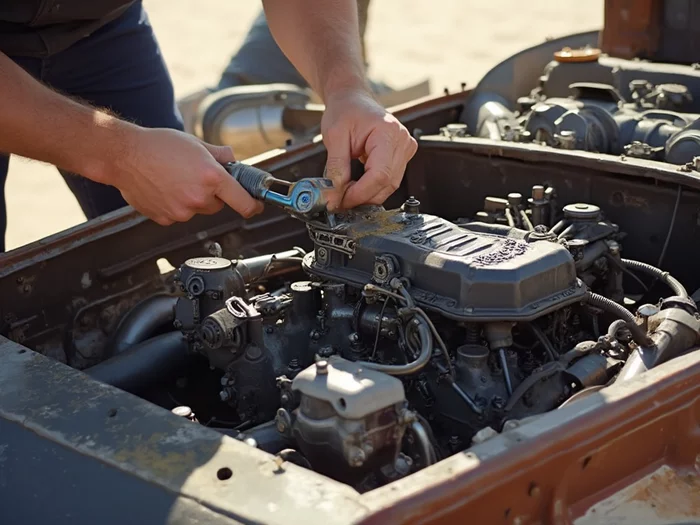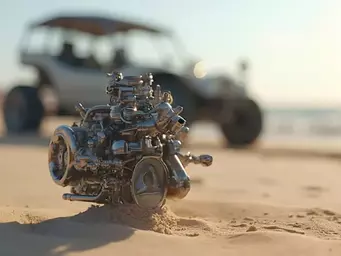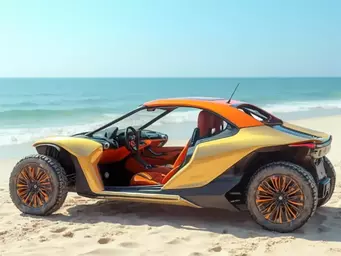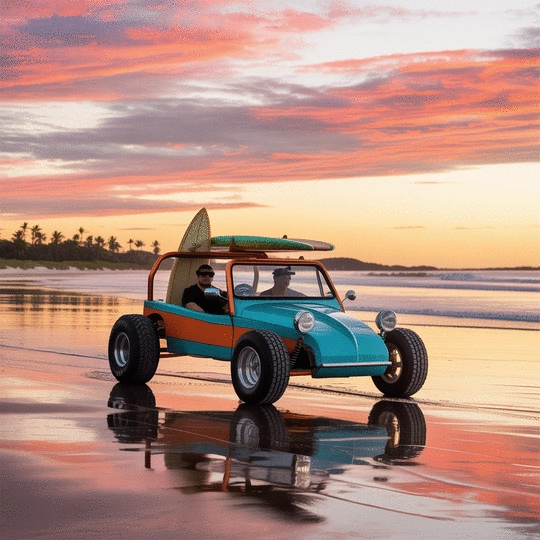Engine Tuning Tips for Beach Buggies

Posted on: 2025-10-09
By: Jasper Quinn
Have you ever found yourself frustrated by unexpected engine issues while cruising in your beach buggy? Understanding the common symptoms and solutions can turn a potential disaster into a smooth ride. Let’s empower your troubleshooting skills!
What You Will Learn
- Recognize key symptoms: Stalling, poor idle, and abnormal smoke colors are crucial indicators of engine tuning issues.
- Diagnose effectively: A step-by-step approach, including checking for air leaks and performing compression tests, can help pinpoint problems.
- Common performance issues: Be aware of engine misfires and overheating, which are prevalent in beach buggies.
- Proactive maintenance: Regular upkeep and community engagement can significantly enhance your beach buggy's performance and longevity.
Beach Buggy Engine Tuning: Common Problems & Diagnostics
Understanding the symptoms of engine issues and following a methodical diagnostic approach are key to maintaining your beach buggy's performance.
Symptoms of Engine Tuning Problems
- ● Engine stalling
- ● Poor idle
- ● Flooding
- ● Abnormal smoke colors
Diagnostic Steps & Common Issues
- ● Check for air leaks
- ● Assess compression loss
- ● Inspect hoses & connections
- ● Review tuning settings
- ● Engine misfire
- ● Overheating
Troubleshooting Engine Tuning Issues in Beach Buggies: Understanding Common Problems
Every beach buggy enthusiast knows that the thrill of an afternoon drive can quickly turn into frustration when engine tuning issues arise. Recognizing the right symptoms is the first step in ensuring your buggy runs smoothly. Engine stalling, poor idle, flooding, and abnormal smoke colors are all indications that something isn't quite right. Let’s dive into these common indicators so you can troubleshoot effectively!
For instance, if your engine suddenly stalls or has a rough idle, it could signal a tuning problem. Additionally, if you notice any unusual smoke colors—like black, blue, or white—it’s essential to take immediate action before the issue worsens. Understanding these symptoms will empower you to take charge of your beach buggy’s performance.
Recognizing the Symptoms of Engine Tuning Problems
- Engine stalling: Sudden stops while driving can indicate serious tuning issues.
- Poor idle: If your engine shakes or struggles to stay running when at a halt, it’s a red flag.
- Flooding: Excessive fuel in the engine can lead to hard starts and poor performance.
- Abnormal smoke colors: Identifying if the smoke is black (rich mixture), blue (oil burning), or white (coolant leak) is vital.
These symptoms are critical indicators of engine health. By paying attention to these signs, we can often prevent more significant problems down the road. If you’ve faced any of these issues, I’d love to hear your experiences in the comments!
Diagnosing the Causes: A Step-by-Step Approach
Once you’ve recognized the symptoms, the next step is diagnosing the cause. This is where a methodical approach can save you time and headaches. Start by checking for potential air leaks, as they can disrupt your engine’s air-fuel mixture. Also, assess for compression loss, which can lead to poor engine performance. For detailed guidance on engine tuning, you can refer to resources like CB Performance's engine tuning section, which provides valuable insights.
Here’s a quick checklist to guide your diagnosis:
- Inspect all hoses and connections for leaks.
- Perform a compression test on each cylinder.
- Review tuning settings to ensure they align with manufacturer specifications, as outlined in guides such as the Idiot Guide from Dune Buggy Warehouse.
Following these steps will help pinpoint the root cause of your tuning issues. Remember, a little patience goes a long way in troubleshooting. If you’re ever unsure, don’t hesitate to seek advice from fellow beach buggy enthusiasts!
Common Issues in Beach Buggy Engine Performance
Beach buggies are unique vehicles that can face specific engine performance problems. Some common issues include engine misfire, which can be caused by faulty spark plugs or incorrect tuning settings. Additionally, overheating is a prevalent concern, especially in hot climates where beach buggies are often driven. For a good discussion on common dune buggy problems and solutions, the Beach Buggy Info forum is a great resource.
Here are a few prevalent engine issues to watch out for:
- Engine misfire: Can lead to reduced power and efficiency.
- Overheating: Causes engine damage if not addressed quickly.
- Driveability problems: Such as stalling or lack of power when accelerating.
Being aware of these potential issues allows us to take proactive steps in maintaining our vehicles. If you’ve experienced any of these problems, feel free to share your solutions below! Your experiences can help out many others in the Beach Buggy Builders community.
Pro Tip
Did you know? Regularly cleaning and inspecting your air filter can greatly improve your engine's performance. A clean air filter ensures that your engine receives the right amount of air, preventing issues like stalling and poor idle. Make it a habit to check it every few months, especially before a big beach outing!
Frequently Asked Questions About Beach Buggy Engine Tuning
What are the most common symptoms of engine tuning problems in a beach buggy?
The most common symptoms include engine stalling, poor idle, flooding, and abnormal smoke colors (black for rich mixture, blue for oil burning, white for coolant leak).
How can I diagnose the cause of engine issues in my beach buggy?
A methodical approach involves checking for air leaks, assessing compression loss, inspecting all hoses and connections, and reviewing tuning settings to ensure they meet manufacturer specifications.
What are some prevalent performance issues specific to beach buggies?
Common issues include engine misfires (often due to faulty spark plugs or incorrect tuning) and overheating, especially in hot conditions where beach buggies are frequently used.
Why is regular maintenance important for my beach buggy's engine?
Regular maintenance, including adjusting carburetor settings, addressing fuel mixture problems, and fine-tuning ignition timing, is crucial for optimal performance, longevity, and preventing major issues from arising.
Where can I find more information and support for beach buggy engine tuning?
You can access additional resources such as video tutorials, community forums like the Beach Buggy Info forum, and specialized repair shops. Connecting with fellow enthusiasts is also a great way to share knowledge and solutions.
Summarizing Key Takeaways on Engine Tuning for Beach Buggies
As we wrap up our exploration of engine tuning for beach buggies, it’s vital to recap the main problems we've discussed. Engine issues can manifest in various ways, from stalling and poor idling to overheating and driveability problems. By understanding these common symptoms and the related diagnostic steps, you'll be better prepared to tackle any challenges that arise with your buggy. Regular maintenance is absolutely crucial for keeping your ride in top shape.
When it comes to solutions, adjusting carburetor settings, addressing lean or rich mixture problems, and fine-tuning ignition timing are all effective strategies. These adjustments can significantly impact your engine's performance and longevity. Remember, staying proactive about these aspects can prevent most issues from ever surfacing!
- Recognize the symptoms of tuning problems early.
- Use methodical diagnostics to pinpoint the cause.
- Implement regular maintenance to ensure optimal performance.
- Engage with fellow enthusiasts for shared knowledge and support.
In summary, keeping your beach buggy's engine tuned is not just about performance; it’s about enhancing your overall driving experience. By taking the time to understand the components involved, you can ensure many fun-filled days on the sand!
Next Steps: Engaging with the Beach Buggy Community
Now that you have a solid foundation in troubleshooting engine tuning issues, I encourage you to share your own experiences with the Beach Buggy Builders community! Whether you’ve faced challenges, found solutions, or simply want to exchange ideas, connecting with fellow enthusiasts can provide ongoing support and inspiration. Join our forums or follow us on social media to stay engaged!
Don't shy away from asking questions—our community thrives on collaboration and mutual assistance. Who knows? Your story could inspire someone else to tackle their own beach buggy project!
Accessing Additional Resources for Troubleshooting
To further aid you on your journey, I recommend checking out some of these valuable resources:
- Video tutorials that walk you through common tuning issues.
- Community forums where you can ask questions and share solutions.
- Specialized repair shops that cater to beach buggy tuning needs.
Utilizing these resources can provide you with the necessary knowledge and confidence to troubleshoot effectively. I'm excited to see how you all apply what you’ve learned here! Let's keep the wheels turning and the engines roaring!
Recap of Key Points
Here is a quick recap of the important points discussed in the article:
- Recognize Symptoms: Watch for engine stalling, poor idling, flooding, and abnormal smoke colors as early signs of tuning issues.
- Methodical Diagnostics: Check for air leaks and perform compression tests to diagnose the root cause of performance problems.
- Regular Maintenance: Schedule regular check-ups and adjustments to ensure optimal engine performance and longevity.
- Engage with the Community: Share experiences and solutions with fellow enthusiasts for support and knowledge exchange.
 What if every turn of the wrench not only transformed your beach buggy but also deepened your passio
What if every turn of the wrench not only transformed your beach buggy but also deepened your passio
 Upgrading your beach buggy isn't just about power—it's a journey towards better performance and en
Upgrading your beach buggy isn't just about power—it's a journey towards better performance and en
 Have you ever felt the thrill of cruising along the shore in a custom beach buggy, the sun warming y
Have you ever felt the thrill of cruising along the shore in a custom beach buggy, the sun warming y
